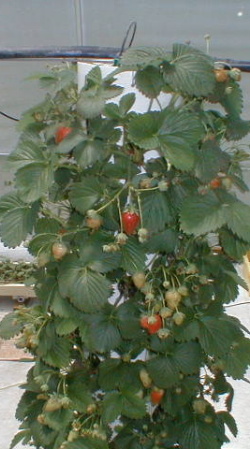Nutrient Film Technique, continued
This is page 6 of our twelve page series on nutrient film technique. Click any of the below pages to jump to that page.
Page 1 Page 2 Page 3 Page 4 Page 5 Page 6 Page 7 Page 8 Page 9 Page 10 Page 11 Page 12

A variation on the NFT theme, with strawberries growing from net pots embedded in a vertical PVC tower. Notice the irrigation tube at the top which directs nutrient solution to cascade down over the roots.
Which Crops Don't Work In Nutrient Film Technique?
Several different categories of crops don’t do very well in conventional nutrient film technique systems, for a variety of reasons:
- Perennial herbs such as rosemary, tarragon, sage, the mints and other woody-stem plants are not generally grown in NFT channels because they grow too tall, and/or because their root systems eventually overwhelm the channels.
- Root crops such as carrots, onions, horseradish, rutabagas, and parsnips won’t work well in NFT because the net pots and NFT channels would distort the tap root shape and size.
- Clumping or matting plants, such as oregano, thyme, grasses, most small grains, etc won’t work well because nutrient film technique systems don’t support the clumping growth habit. While individual plants could certainly be germinated and rooted within an NFT system, any given NFT system would be impractically large. Other hydroponic methods such as flood and drain, where these crops’ clumping and matting nature can flourish, would be much more cost effective. I’m going to include mesclun in this group because mesclun is planted so densely. While mesclun could certainly be raised via nutrient film technique, the system limitations would in turn limit the density in which the crop could be planted. In other words, you could harvest many times more plants in another hydroponic system taking up the same floor area as would an NFT system. The numbers simply dictate that some other system would give you a lot more harvest, for a lot less space and expense.
- Tall or large plants such as rhubarb, chard, corn, some varieties of kale, and collards because they are simply too large. Their roots would quickly overwhelm the NFT channels, and a lot of linear channel space would be wasted between plants.
- A lot of the above list was evaluated assuming that a grower wanted to use their equipment/or grow their crops, as cost effectively as possible. Having said that, the NFT channel approach could theoretically work for any plant if you were willing to sacrifice that cost effectiveness.
Never Say Never with Nutrient Film Technique
As we have already discussed on a previous page, NFT is still an evolving approach, with a lot of potential yet for new crops. If any of the crops above are on your personal "want to grow using NFT" list, then by all means look at ways to accomplish that goal. For large plants and/or perennial crops, perhaps use a deeper and/or wider channel. For cascading plants, try using channels which have more space between them and/or mount them higher off the ground.
Plant with taproots would be a challenge. A very deep channel would allow sufficient room for taproot development, but a way would have to be found to suspend the plant within the channel. One possibility would be some kind of elastic pocket which would expand as the taproot grew. Imagination knows no bounds, and necessity has been (and remains) the mother of invention. So, if taproot plants are on your to-do list, by all means get creative.
Plants which have a matting or clumping habit would also pose a challenge. One way to overcome this challenge would be to use wider, yet still shallow channels, combined with some kind of net pot that could hold a clump or mat of plants. While I personally have not seen NFT-specific net pots which might work, the standard plastic baskets used to sell berries would be a fairly close approximation. Those plastic baskets would be large enough for small clumps, shallow enough for each plant's roots to reach the channel floor, and the plastic would last for at least a few seasons' worth of growth.
If you do come up with a novel way to grow any of these challenging crops in NFT, by all means share! If you like, Contact Us and we'll not only share your development, but also give you credit for your innovation.
Back Next
Click any of the below links to jump to that page.
Page 1 Page 2 Page 3 Page 4 Page 5 Page 6 Page 7 Page 8 Page 9 Page 10 Page 11 Page 12